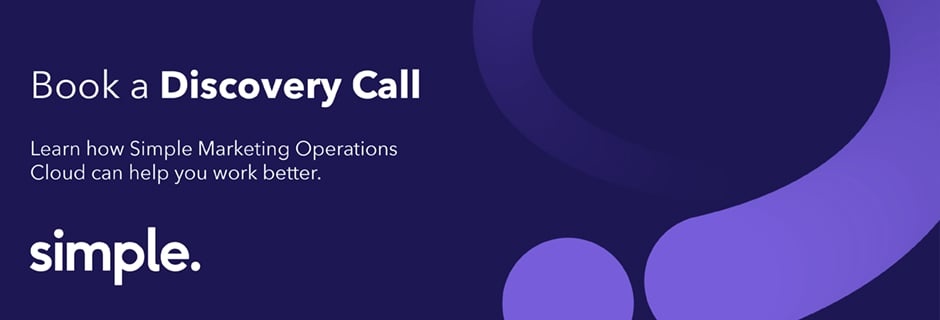Balancing Agile Marketing and the Creative Process
Balancing agile marketing and the creative process
Agile marketing and the big creative idea: can they be cosy bedfellows or are they mutually exclusive?

If you’re a regular reader of the Simple blog, you’d be familiar by now with agile marketing. Many of you are already experimenting with agile processes: perhaps you already hold daily standups; or you use a Kanban board to manage projects.
The application of agile work principles to marketing prioritises smaller projects that can be conducted more quickly than big-bang campaigns, generating data that can be used to iterate and improve outcomes in the short term.
That — the theory goes — enables teams to increase the visibility and responsiveness of their marketing activity, reducing risk and increasing gains over the long term.
But how does that work when it comes to the creative process? In Adland, the creative process many agencies have traditionally used happens in well-defined consecutive steps (known as ‘waterfall’) — they get a brief, come back with a creative presentation, the client signs off on the concept, the agency goes away and develops it, the client buys the work.
Sometimes it is pre-tested or researched prior to launch and changes made, but the whole campaign is a known quantity at the time of launch, and often has a definitive end point based on the pre-booked media schedule.
So how can agile marketing and the creative process co-exist? How can brands strike a balance between responsiveness and creativity?
Got more questions about agile marketing? Download your free e-book: Agile Marketing FAQs for CEOs and CMOs
Iterative campaigns based on a big creative idea
Marketing consultant and TrinityP3 founder Darren Woolley has some views on how agile marketing can be applied to big brand campaigns. “In agile marketing, the big idea unifies the brand and is delivered as a series of incremental campaigns,” Woolley says.
“The most powerful brands are the ones that navigate to a big idea over time. It’s the anchor through which customers build a relationship with a brand.
“You can’t test and learn your brand campaign: these brands make their big ads and then they execute them.In agile marketing, you set your objective, and you test and learn to find the best way to achieve that objective.”
A test-and-learn process used to define the creative execution, based on the big creative idea, is the simplest way to make progress towards greater agility.
“Your media agency could test concepts in a couple of hours,” Woolley says. “If you test and learn so you learn what doesn’t work, then it’s valuable testing and learning.”
The underlying ‘truth’ doesn’t change
Founder and creative director of boutique travel agency No Vacancy, Nick Bonney, has worked in traditional waterfall creative agencies such as Clemenger Sydney and M&C Saatchi, and has also worked in an agile creative team.
He says the key to balancing the big idea and agility are that the underlying consumer truth shouldn’t change.
“Sure I think you can be ‘agile’ and have a big idea,” Bonney says. “To me, big ideas are insight-led, creative-driven thoughts that can extend across any channel and are most often built around a consumer or product truth.
“Big ideas also ensure you remain consistent which is vital in not confusing your customers.
“Agile is then a process of working that allows you to adapt and change the messaging based on feedback, testing and trends"
“I don’t think agile should change the ‘big idea’ necessarily as a good strategically thought-out idea will be effective if it’s based on a consumer or product truth. Agile marketing is also a way of getting work done efficiently and making sure you keep on track.'
“Unlike traditional process, where you would spend months on one campaign before you release it (only to find out consumer trends have changed), I like how agile marketing allows you to feed small tests into the marketplace.'
Iterative briefing
Marketer Jenny Williams, CMO at Compare the Market, has been frustrated with the “black box” approach to creative development insisted on by many creative agencies, in which agencies would work for a month on their own and then present creative concepts without the benefit of being able to refine the idea in that time.
“We’ve refined (the briefing process) to a whole new level so it’s very much iterative,” Williams told Simple. “We’re having incremental meetings with either internal stakeholders or agencies that we’re going to partner with on particular things.
“Every time we have a meeting, some new insight that we need to think about or refine or figure out comes up and we try to solve it then or we go away and solve it in the interim so we’re continuing to refine the thinking.
“As we have those meetings and the conversations, we’re updating the brief. When we get to the all-agency briefing, it’s going to be a fairly well-baked idea, plan, structure. There’s not a whole bunch of open questions.”
The in-house option
According to Dany Milham, founder of mattress retailer Koala, agile marketing is much easier if the creative process is in-house. Koala has now brought media buying in-house and limited media lead times to no more than a month in advance, to maximise test-and-learn cycles and agile responsiveness.
“As soon as you have contractors who aren’t in your team it does get really hard, and does break (those agile processes),” Milham says — although he adds it can work if brand teams have someone at the agency who is in your daily standups and available throughout the day.
Download the e-book: Hack Agile Marketing in 8 Simple Steps
“Doing things in-house allows us the agility to be able to change our creative or campaigns on an hourly or daily basis,” he says.
“For example, we now have a creative director always working on ads on a weekly basis. We have a good content website that will be pushed out soon. That’s all done in-house and aligns with our SEO strategy.”
The company is moving into AM radio and day-time TV as it builds awareness among new customer segments.
And in-house loyalty marketing and data analysis enables the company to conduct research with its Koala Club members and test new concepts prior to a bigger launch.
Media testing or AB tests on digital creative executions in-campaign are probably the most common ways brands attempt to increase their responsiveness, but so long as the consumer truth or insight is constant, many other elements of your typical advertising campaign are up for grabs, from briefing through to iterative campaign development.
Read next: 9 Essential Tools to Scale Agile Marketing

